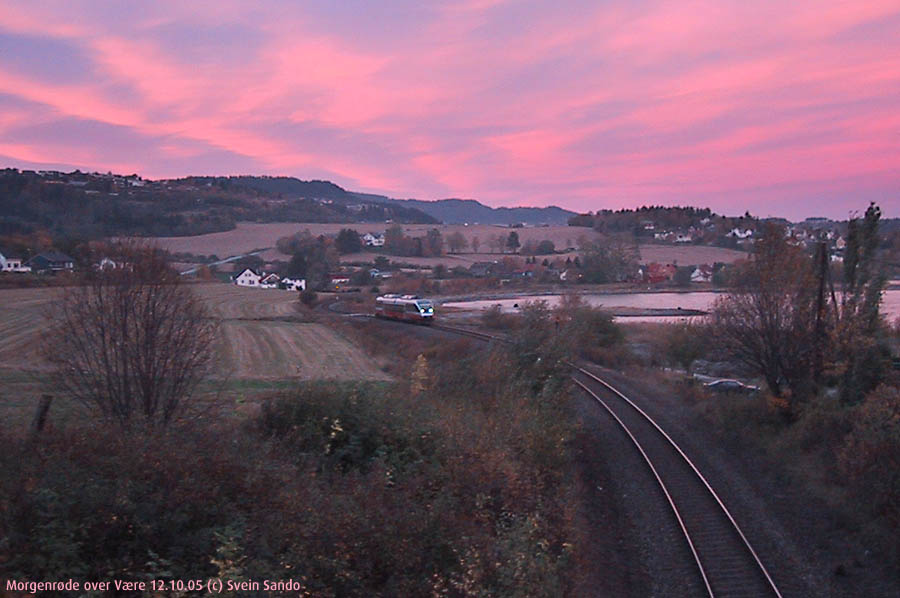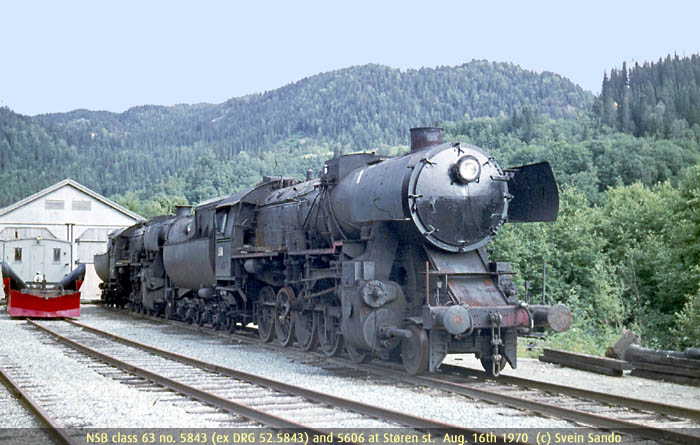|
Problems with identification of steam locomotives NSB 63a 5839-65, claimed to be formerly DRG BR 52.5839-65 by Svein Sando, Trondheim, Norway
The question below and the following debate could once be read at http://www.german-railways.com/Interactive/General/QsAndAs/1999Oct493457.htm (not available July 2003) Ingo Hütter (EMail: ingo.huetter@gmx.de) from Hannover (Germany)
on Oct 4 1999, 9:34 Having access to the original boiler repair manuals of the Norwegian State Railways, I started a more accurate examination of the whole series 5839-65 of which NSB claims to have received all except 5840, 5859, 5861 and 5864. The peculiar thing with these engines is that we have no record of these engines works number. The engines are claimed to be built by Schichau, Elbing. In a letter from Hansjürgen Wenzel 12.1.1980 to Norwegian Railway Club he writes: Die Norwegenlok gingen eier Anordning des Reichsverkehrsministeriums zufolge im
September und Oktober 1944 alle in den Bestand der Rbd Hamburg. Lok die später nach
Norwegen gingen, kamen zugleich mit der Abgabe (...) an Norwegen in den Bestand der Rbd
Hamburg. Leider sind die Unterlagen nicht vollständig. ... Translation to English: The Norwegian engines were, according to a decision in the
Reichsverkehrsministerium [a federal administration of transport] in September and October
1944, enrolled in the roster of the Rbd [regional railway administration] Hamburg. Engines
that at a later date was transferred to Norway from other Rbds were likewise enrolled in
the Hamburg roster. The sources are regrettably not complete. ... We have also a suggestion for works numbers form these engines by the Danish P. S. Eilertsen, Åbybro, given in 1980. Let us put all the known figures in a table:
All engines are reported by NSB to be received as almost unused ones in March 1944, except 5860 and 5865 which arrived as late as June (sic!) and April 1945. Wenzel writes, in the above cited letter, that the engines had to be used in Germany (i.e. by Hamburg Rbd for most of these engines) for at least a few weeks before being send to Norway in case of repairs due to production failures. With respect of 5863, Wenzel reports from hardly readable hand-written sources, that Rbd Hamburg received 5863 (among a lot of other Norwegian 52-ies) from Rbd Stettin 31.10.1944. This was however a formally transfer only, in order to place the engines running in Norwegian under one single adminstrative in Germany, namely Hamburg Rbd. Home engine shed (Heimat-Bw) was Wittenberg for all these engines, even though none of these engines ever came to Wittenberge. 5863 was consequently administratively transferred to Hamburg Rbd which was normally for an engine running i Norway. This is an argument for 5863 in Norway being the real 5863. However, take a closer look at the tables lower part where 5863 is located. The fourth column shows the difference between works number and boiler number. According to Wenzel, this difference should never exceed 99 if the boilers were fit on the frames in strict sequence, i.e. an increase in engine number should be followed by an increase in frame number (works number) and boiler number. The list shows that the boilers were put on the frames in a somewhat mixed sequence. Once an engine was ready to be equipped with boiler, it received one even if the strict numerical order were broken. This was wartime and engines were needed as soon as possible. The tendency of the engines down to 5858 is however clear, the 99 foreign boilers seems to have been put on engines before this series of engines starting with 5844. We can see, in fact than one foreign boiler was put on 5843. It strikes me however that most of the engines carries a boiler which has a boiler number that is exactly 100 less than the frame, and not 99 as expected. Was it perhaps 100 boilers that Schichau had made at other works? With engines 5860-5865 the situation is however different. Any system seems to vanish completely. According to Wenzel, there is a jump in works numbers from 5861 (which never came to Norway). This jump, however, ought not to not imply a jump in the difference in works number vs boiler number since the 99 foreign boilers are already used on previous engines. The boiler numbers of 5862-5863 seems to be too low as the difference is 135/133. There might be several ways to explain that. I will try to give one solution below. We know from NSB sources the dates when the engines (or boilers?) were ready, also 5860 and 5865 which arrived Norway after a year in service other places. Suppose the works number was decided when the engine was ready to leave the factory. The works numbers that I have referred to above as Wenzel's is actually a series of numbers spread sequentially. Suppose the sequence was arranged after this date of delivery, and not a sequence matching the BR 52-numbers. I have simulated this in the table below which sorts the engines after date of delivery, and then proposing new works numbers:
Two remarkable things can be shown by this table: 1. The average of the difference between new works number and boiler number for the series 4176 - 4192 (new series) is exactly 99,00! 2. 5863 is the only engine with significant deviation from the expected difference of 99. I think this shows that the theory of numbering the frames (works numbers) according to date of delivery is a reasonable theory unless we have other written documentation that states otherwise. This also confirms Wenzel's information about the lacking 99 boilers and it makes it most probable that 5843 is the last one with foreign boiler. Secondly, there is something wrong with number 5863 as Ingo Hütter originally asked. Is the digit "5863" wrong on the NSB 52.5863? Should it have another number? In case, which number? To answer this, one has to know the fate of the other Schichau-engines, which is for the present unknown to me. But perhaps some of the readers of this webpage do? In the series 5839-5865 most of them was used in Norway, but not 5859, 5861 and 5865. The only way to avoid the large difference figure 132 is to put "5863" in the series with works numbers 4172-4193. 5859 is the only free number. But is it really free? Any viewpoint or information are welcome! Ingo Hütter answered Oct 25th 1999: Thanks to Svein Sando for the interesting work he did. The
question I asked is still open, but nevertheless we now have some details on the other NSB
locos, which might help to find a solution for this problem. I received an e-mail from David J Fakes, England in July 2003: I have recently seen your page on the
identities of 63a. I have not much to
add except to say that 5865 carried frame number
4216 when examined at Bressingham. Also the
Russians had a habit of 'exchanging' locos on cross border workings
either because of a failed loco or because there was a much better
one available. This may account for some locos appearing to be owned by both
Russia and a satellite country! The initial boilers of these engines was:
This article is shown 227432 times |
|||||||||||||||||||||||||||||||||||||||||||||||||||||||||||||||||||||||||||||||||||||||||||||||||||||||||||||||||||||||||||||||||||||||||||||||||||||||||||||||||||||||||||||||||||||||||||||||||||||||||||||||||||||||||||||||||||||||||||||||||||||||||||||||||||||||||||||||||||||||||||||||||||||||||||||||||||||||||||||||||||||||||||||||||||||||||||||||||||||||||||||||||||||||||||||||||||||||||||||||||||||||||||||||||||||||||||||||||||||||||||||||||||
| Ett tilfeldig blant 106 jernbanebilder jeg har fotografert selv: | ||||||||||||||||||||||||||||||||||||||||||||||||||||||||||||||||||||||||||||||||||||||||||||||||||||||||||||||||||||||||||||||||||||||||||||||||||||||||||||||||||||||||||||||||||||||||||||||||||||||||||||||||||||||||||||||||||||||||||||||||||||||||||||||||||||||||||||||||||||||||||||||||||||||||||||||||||||||||||||||||||||||||||||||||||||||||||||||||||||||||||||||||||||||||||||||||||||||||||||||||||||||||||||||||||||||||||||||||||||||||||||||||||||
 | ||||||||||||||||||||||||||||||||||||||||||||||||||||||||||||||||||||||||||||||||||||||||||||||||||||||||||||||||||||||||||||||||||||||||||||||||||||||||||||||||||||||||||||||||||||||||||||||||||||||||||||||||||||||||||||||||||||||||||||||||||||||||||||||||||||||||||||||||||||||||||||||||||||||||||||||||||||||||||||||||||||||||||||||||||||||||||||||||||||||||||||||||||||||||||||||||||||||||||||||||||||||||||||||||||||||||||||||||||||||||||||||||||||
I dag 1538 treff på ses-jernbane, og 6552966 totalt siden 09.05.2004 11:49. Dagsgjennomsnitt: 831 treff ·
| © Svein Sando |
| Start page (Eng.) · Startside (Norw.) · · Display modes: Standard · Without menus: Arial · Times · Times spacious · Large · |
The content of this webpage is subject to Norwegian legislation about copyright, which gives the author all publications wrights. Any further publication of this text and its pictures, completely or partly, can only be done after being authorized to do so by the author. Shorter citation in papers, students essays and so forth can be done if referring to the source. APA style reference to this webpage:
Sando, S. (2003). Problems with identification of steam locomotives NSB 63a 5839-65, claimed to be formerly DRG BR 52.. Downloaded 13.12.2025 from https://www.sando.co/index.php?vis=143&nid=2&eng=1
Php-versjon 7.4.33

